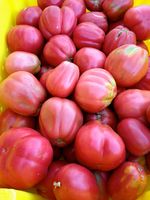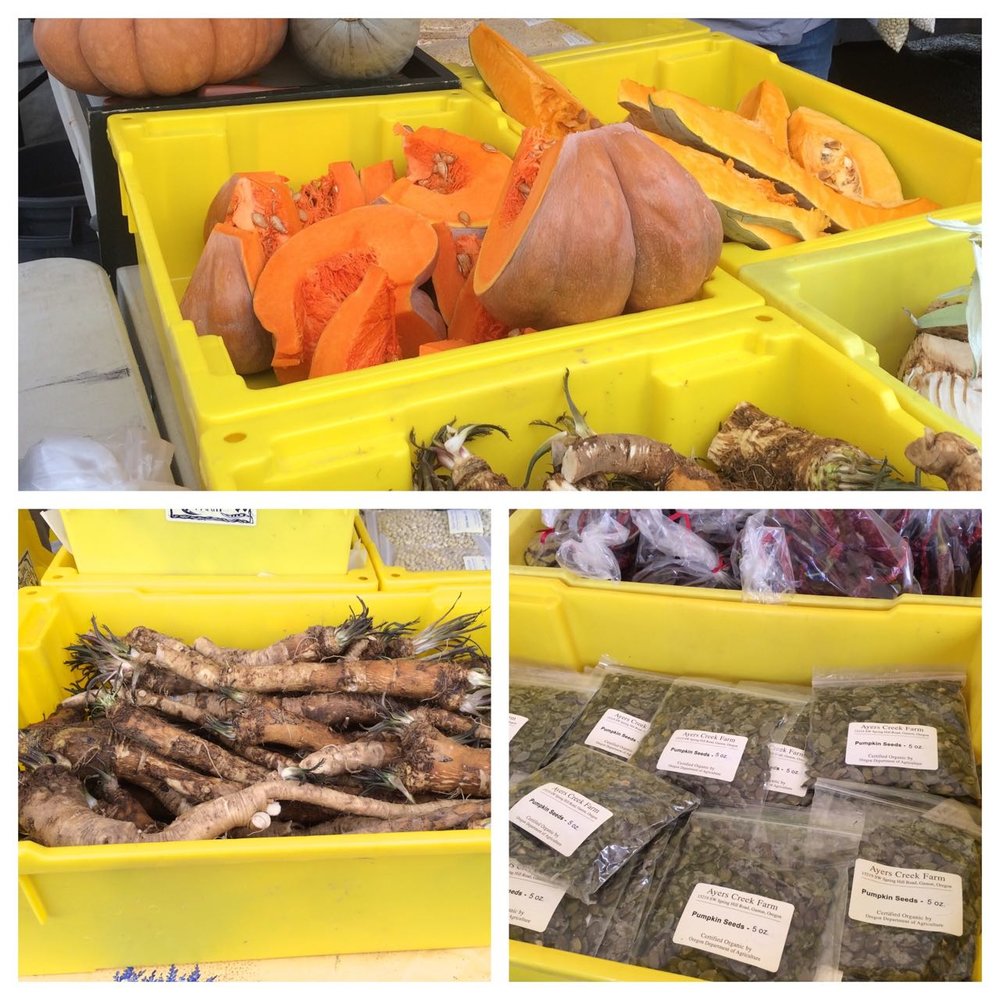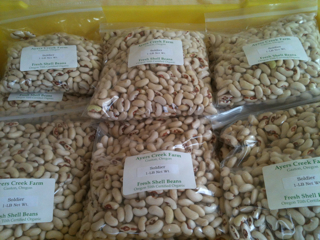Ayers Creek Farm Newsletter September 14 2014
Guest User
 The bean harvest is now in full gear, and it will be the year of bean. Chicories and other winter greens are growing at a good pace. We will take a few hours off to stand about at Hillsdale Farmers Market. Hope you all come and keep us company.
The bean harvest is now in full gear, and it will be the year of bean. Chicories and other winter greens are growing at a good pace. We will take a few hours off to stand about at Hillsdale Farmers Market. Hope you all come and keep us company.
No beans until next week, they still need cleaning and another few days to dry completely, but we will have good food otherwise.
Here is what we will have:
Tomatoes: Astianas for sauce and Striped German for slicers. With this warm weather, we will again have a good supply of the Astianas. Our fashionable new lugs arrived which will make it easier to haul your tomatoes from the market. Oh yes, Striped Germans will be on this week's menu.
Tomatillos - purple
Grains: Frikeh, barley and Amish Butter popcorn.
Fenugreek
Plums: German and Croatian prunes, mirabelle and golden gages.
Grapes: a mixture of celibate and fecund sorts. We will have Price, A Grape with No Name, Interlaken. The latter make very good raisins.
Preserves and, as usual, some other odds and ends.
Michael Abelman and his son Aaron stopped by Ayers Creek for a few days in late July 2004 as part of his Fields of Plenty project. Rereading the profile a decade later, it is striking how much things have changed, though fundamentally we are the same farm. The profile celebrated the summer here, but we already had one winter market season under our belt. That spring we learned that the combination of spring break, Easter and Passover can kill a market. Lowest gross we have ever had; when vendors leave their cash box unattended there is not much to say for the day. Also learned that we should grow horseradish. Somehow, black radish does not have the same allure as a bitter herb for the seder, much as we tried laud its many virtues. Our first planting of Roy's Calais flint corn was in the ground, and we were planning our orchard and vineyard.
After leaving Gaston, Michael visited Jennifer Greene's Windborne Farm in Scott Valley. There he fell in love with her old Allis Chalmers All Crop. It is a small combine pulled by a farm tractor. A combine gets its name because it combines the formerly separate tasks of cutting, threshing, and winnowing seed crops, including legumes and grains.
A couple months later he located a pair for sale in Canby, one apparently almost running and a decrepit example for parts. We went to see them with him, and it was clear the rose's bloom was withering as he paced around the two dusty, rusty hunks of machinery with their frayed belts, broken reel bats and rotting tires. We shared his reservations, even as he clung to the memory of Jennifer's machine and all it could do. The challenge of transporting the machines to Foxglove Farm on Salt Spring Island and repairing them dislodged the yearning.
Apparently, the pathos of the bedraggled machines and their potential gnawed at us. Not sure what exactly happened to dislodge us from our rational frame of mind, but we purchased them. The machine is boxy with most of its drives on the outside. Like Han Solo's Millennium Falcon, it is meant to be repaired on the fly with materials at hand. Not sleek or elegant, just enough of it to carry out the task well. Perhaps the idea opening up the list of crops we grow had some influence.
Other farmers with big machines speak admiringly of the All Crop, with its mixture of flexibility, simplicity and economy. Encouraging the endeavor, not emulating it, mind you. They take their old combines to the Banks demolition derby, not the shop. They are quite comfortable in their modern air-conditioned cabs with stereo and computer controls. In less than an hour, they can harvest more grain than the All Crop can in a day. However, their machines take a full day to clean between crops, and the All Crop is clean and greased in less than an hour.
Drawn to the machine, we forgot the first rule of purchasing equipment; turn over the engine to make sure it is operable. Apparently, someone tried to start the engine by using a lot of starter fluid (ether) which cleaned all the oil off the cylinder walls and the engine corroded solid. Neither Marvel Mystery Oil nor grease pumped into the cylinder would dislodge the corroded pistons. Perhaps we would have purchased it anyway, but it threw a disappointing money wrench into the works. The All Crop took a backseat to other projects until our daughter married Jonathan Hunt. In March 2008, he visited and helped strip down the machine. Later he found us an old driveshaft to replace the engine. Relentlessly, he peeled away the excuses for delaying and pushed us to get it running.
Restoring farm equipment as a show piece is very different from a functional restoration. We want the machine to operate for thousands of more hours reliably, so pulleys, shafts and bearings need cleaning and, if necessary, replaced. Rubber and wood parts likewise. Tom Yasnowski specializes in locating or replicating obsolete Allis Chalmers parts, supplying us with the belts and rubber parts that had disintegrated over the decades. The cylinder and concave chamber where the threshing of the seeds takes place needed a complete overhaul. Yasnowski supplied replacement rubber-faced bars for the cylinder and Dave Naumann at Ernst Hardware in St. Paul helped us locate a shop where the cylinder was balanced. It spins at high speed and balanced with modern equipment it runs as smooth as silk. Being an old piece of machinery, we deemed it acceptable to keep the bullet holes that appear when machines are unattended for a while in rural America.
We replaced upwards of 100 corroded bolts holding together the 10-foot long straw rack, and saturated the dry wood with linseed oil. The adjustable cleaning shoe is where the seed is separated from the chaff, the winnowing task. It had corroded in place making adjustments impossible, requiring several days of careful cleaning and lubrication, and a layer of linseed oil on the wooden parts.
A couple of weeks ago, Jon took his place on the bagger's platform where the seeds drop into sacks. We put in a couple of hours figuring out the fine points of combining chickpeas. As we tried to communicate over the roar of the tractor, the rattling of grain conveying chains, and the thrashing cylinder, I might have well have been communicating with a wookiee. It was great to see the patina of a working machine return, that fragrant, short-lived gloss from the resins of the plants. Some of you may have picked up on the fragrance in the barley, and it will be present in the chickpeas as well. There was a Queen Ann's Lace growing in the field, giving the grain a hint of wild carrot aroma. Thanks, Jon.
Carol






